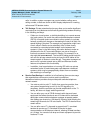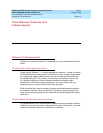
MERLIN LEGEND Communications System Release 6.0
System Manager’s Guide
555-660-118
Issue 1
February 1998
New Features and Enhancements
Page xviiiRelease 6.0 Enhancements
calls. In addition, system managers can control whether calling name,
calling number, or both are shown at MLX display telephone for incoming
calls across PRI tandem trunks.
■ Toll Savings. Private networked trunks may allow you to realize significant
cost savings on long-distance and toll calls by performing tandem switching
in the following two ways:
— Callers on a local system, or individuals dialing in to remote access
at a local system, can reach the public switched telephone network
(PSTN) via outside trunks connected to other systems in a private
network, avoiding toll charges or decreasing the cost of toll calls. No
special dialing is required. For example, an organization might have
a main office in Boston and a subsidiary office in New Jersey,
connected by networked private tandem trunks between two
systems. A user in the New Jersey office who wishes to make an
outside call to the 617 area code (Boston) can do so through a
line/trunk connected to the system in Boston. For example, he or
she might dial,
. The local ARS tables would route this
call over the private network trunks and use the ARS tables of the
remote system in Boston to route this call. The system managers at
each end of a private network set up ARS and Remote Access
features to implement this functionality.
— In addition, local organizations or incoming DID calls use private
networked trunks to make intersystem calls between networked
systems, which may be geographically distant from one another,
also resulting in toll savings.
■ Service Cost Savings. In addition to toll call saving, there are two ways
that organizations can save on service costs incurred from
telecommunications providers that provide public switched telephone
network access:
— You order a point to point T1 facility from a service provider, then
use system programming to set it up for PRI signalling. As
necessary, a service provider can provide amplification on the T1
facility, but does not supply switching services.
— You can tailor your use of PRI B-channels with drop-and-insert
equipment that allows fractional use of B-channels for dedicated
data/video communications between systems at speeds greater
than 64kbps per channel or 128 kbps for 2B data, while keeping the
remaining B-channels for PRI voice traffic. The PRI D-channel must
remain active.
— You can tailor use of T1 channels to support both T1-emulated
tandem tie service and T1 Switched 56 service for data
communications at 56 kbps per channel, allowing 2B data transfers
at 112 kbps. You can also use drop-and-insert equipment to provide
fractional T1 use.


















